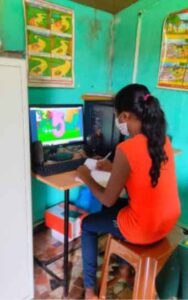By Kavita Anand, Co-Founder and Director, Adhyayan Quality Education Foundation and an Ashoka Fellow, Maharashtra, India. (Southasiadisasters.net issue No. 193, July 2021)

The onset of the second wave didn’t strike most people as significant. When it was announced, it appeared to be spiking in a few places in the country and the official line was one of apparently having beaten back the virus. So when the numbers began to leap off the charts and the actual success of the virus’s mutant new avatar became apparent, it meant that 400 million children were looking at a bleak time yet again. Their schools had already been closed for a year and the second wave meant more months of closure. For those in their final school examination years, the decision to cancel examinations has meant living in limbo, with no clear understanding of how they can take next steps for getting work or getting into higher education and vocational schools.
For the urban child, the pandemic months have also been about living in constant fear and in lockdown with illness in the family and the neighbourhood. For many, it has been learning from an experience of death at close quarters. They have seen their parents either losing jobs or if lucky, working from home, albeit with the greatest difficulty. Some children have had to pack up their homes and accompany their families as they walked back to their villages or accepted the possibility of being infected in trains and buses packed to capacity. Whether they went or stayed, the loss of friends, play and the mid-day meal further added to their miserable loss of learning.
Those that have stayed on in the cities have borne the brunt of being with their families 24/7, often in small flats or housing that has in some cases, shared toilet facilities and low water availability. Worse, the parents’ loss of income combined with immobility has had children becoming easy targets for adult frustration. There is alarming news of increasing spouse and child abuse. While child helplines have reported a spike in calls, nearly 92,000 SOS calls in March and April last year on The Child line India helpline asking for protection from abuse and violence, the truth is children need to borrow their parents phones to make those phone calls. Most children have been unable to speak with anyone outside of their family, and in cases where both parents have been ill, have also had to take over the management of the family’s daily living and care.
While more than 50% of urban children would normally have been attending private schools, the numbers of those who have been able to pay their fees and get access to their teachers online is relatively low. Children with devices of their own that they can dedicate to their education are usually secondary or higher secondary students except in the high fee paying schools. The others have had to make do with a shared device, getting at most 30 minutes a day of instruction and that of variable quality. Contrast this with the 5 to 6 hours of daily instruction that they were used to, and the loss of learning becomes obvious. Those in the government schools have to be satisfied with televised education or radio programmes. For more than 14 months WhatsApp messages are what has passed for education. All this is increasing the likelihood of dropouts and early marriages especially for the girl child.
For their teachers too, life has been full of uncertainties and hardships of having to figure out ways to reach as many students online as possible. The urban teacher has had to deal with the trauma of learning tech skills in full view of their families, teaching while looking after their own children’s education, and letting their students’ families into their homes. Many teachers of affordable private schools mushrooming in cities have lost partial or their entire income. Schools have been at loggerheads with parents over fees and the courts have had to intervene.
The tuition teachers who had kept the students’ learning going in many towns and cities have been more cautious during the second wave. Consequently, WhatsApp has become the “teacher” that most certainly cannot discriminate between truth and fiction. Rumours therefore, abound. Rumours about the greater impact of the second wave on children are making families fearful of sending their children anywhere, not even for learning. Rumours about the “dangers” of vaccination and the difficulty of booking their turn on the app have meant greater reluctance and often plain inability to create the conditions that will stop a third wave.
Sadly, the reluctance of both parents and children to wear masks and maintain the appropriate physical distance in crowded streets and marketplaces, means that the population remains ignorant of safety protocols and vulnerable to the mutation of the virus. Till schools re-open, primary school students are unlikely to get the remedial support they need to be able to learn at their level. And secondary school students will continue to report an increasing addiction to social media.
Disclaimer: The views expressed in this piece are those of the author/s and do not necessarily reflect the views or policies of AIDMI.